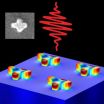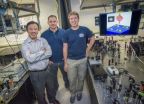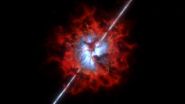(Press-News.org) An advance has been achieved towards next generation ultrasonic imaging with potentially 1,000 times higher resolution than today's medical ultrasounds. Researchers with the U.S. Department of Energy (DOE)'s Lawrence Berkeley National Laboratory (Berkeley Lab) have demonstrated a technique for producing, detecting and controlling ultrahigh frequency sound waves at the nanometer scale.
Through a combination of subpicosecond laser pulses and unique nanostructures, a team led by Xiang Zhang, a faculty scientist with Berkeley Lab's Materials Sciences Division, produced acoustic phonons – quasi-particles of vibrational energy that move through an atomic lattice as sound waves - at a frequency of 10 gigahertz (10 billion cycles per second). By comparison, medical ultrasounds today typically reach a frequency of only about 20 megahertz (20 million cycles per second.) The 10GHz phonons not only promise unprecedented resolution for acoustic imaging, they also can be used to "see" subsurface structures in nanoscale systems that optical and electron microscopes cannot.
"We have demonstrated optical coherent manipulation and detection of the acoustic phonons in nanostructures that offer new possibilities in the development of coherent phonon sources and nano-phononic devices for chemical sensing, thermal energy management and communications," says Zhang, who also holds the Ernest S. Kuh Endowed Chair Professor at the University of California (UC) Berkeley. In addition, he directs the National Science Foundation's Nano-scale Science and Engineering Center, and is a member of the Kavli Energy NanoSciences Institute at Berkeley.
Zhang is the corresponding author of a paper describing this research in Nature Communications. The paper is titled "Ultrafast Acousto-plasmonic Control and Sensing in Complex Nanostructures." The lead authors are Kevin O'Brien and Norberto Daniel Lanzillotti-Kimura, members of Zhang's research group. Other co-authors are Junsuk Rho, Haim Suchowski and Xiaobo Yin.
Acoustic imaging offers certain advantages over optical imaging. The ability of sound waves to safely pass through biological tissue has made sonograms a popular medical diagnostic tool. Sound waves have also become a valuable tool for the non-destructive testing of materials. In recent years, ultrahigh frequency sound waves have been the subject of intense scientific study. Phonons at GHz frequencies can pass through materials that are opaque to photons, the particles that carry light. Higher frequency phonons also travel at smaller wavelengths, leading to a sharper resolution in ultrasound imaging.
The biggest challenge has been to find effective ways of generating, detecting and controlling ultrahigh frequency sound waves. Zhang, O'Brien, Lanzillotti-Kimura and their colleagues were able to meet this challenge through the design of nanostructures that support multiple modes of both phonons and plasmons. A plasmon is a wave that rolls through the conduction electrons on the surface of a metal.
"Through the interplay between phonons and localized surface plasmons, we can detect the spatial properties of complex phonon modes below the optical wavelength," O'Brien says. "This allows us to detect complex nanomechanical dynamics using polarization-resolved transient absorption spectroscopy."
Plasmons can be used to confine light in subwavelength dimensions and are considered to be good candidates for manipulating nanoscale mechanical motion because of their large absorption cross-sections, subwavelength field localization, and high sensitivity to geometry and refractive index changes.
"To generate 10 GHz acoustic frequencies in our plasmonic nanostructures we use a technique known as picosecond ultrasonics," O'Brien says. "Sub-picosecond pulses of laser light excite plasmons which dissipate their energy as heat. The nanostructure rapidly expands and generates coherent acoustic phonons. This process transduces photons from the laser into coherent phonons."
To detect these coherent phonons, a second laser pulse is used to excite probe surface plasmons. As these plasmons move across the surface of the nanostructure, their resonance frequency shifts as the nanostructure geometry becomes distorted by the phonons. This enables the researchers to optically detect mechanical motion on the nanoscale.
"We're able to sense ultrafast motion along the different axes of our nanostructures simply by rotating the polarization of the probe pulse," says Lanzillotti-Kimura. "Since we've shown that the polarization of the pump pulse doesn't make a difference in our nanostructures due to hot electron diffusion, we can tailor the phonon modes which are excited by designing the symmetry of the nanostructure."
The plasmonic nanostructures that Zhang, O'Brien, Lanzillotti-Kimura and their colleagues designed are made of gold and shaped like a Swiss-cross. Each cross is 35 nanometers thick with horizontal and vertical arm lengths of 120 and 90 nanometers, respectively. When the two arms oscillate in phase, the crosses generate symmetric phonons. When the arms oscillate out of phase, anti-symmetric phonons are generated.
"The phase differences in the phonon modes produce an interference effect that allow us to distinguish between symmetric and anti-symmetric phonon modes using localized surface plasmons," O'Brien says. "Being able to generate and detect phonon modes with different symmetries or spatial distributions in a structure improves our ability to detect nanoscale motion and is a step towards some potential applications of ultrahigh frequency acoustic phonons."
By allowing researchers to selectively excite and detect GHz mechanical motion, the Swiss-cross design of the plasmonic nanostructures provides the control and sensing capabilities needed for ultrahigh frequency acoustic imaging. For the material sciences, the acoustic vibrations can be used as nanoscale "hammers" to impose physical strains along different axes at ultrahigh frequencies. This strain can then be detected by observing the plasmonic response. Zhang and his research group are planning to use these nanoscale hammers to generate and detect ultrafast vibrations in other systems such as two-dimensional materials.
INFORMATION:
This research was supported by the DOE Office of Science through the Energy Frontier Research Center program.
Lawrence Berkeley National Laboratory addresses the world's most urgent scientific challenges by advancing sustainable energy, protecting human health, creating new materials, and revealing the origin and fate of the universe. Founded in 1931, Berkeley Lab's scientific expertise has been recognized with 13 Nobel prizes. The University of California manages Berkeley Lab for the U.S. Department of Energy's Office of Science. For more, visit http://www.lbl.gov.
The DOE Office of Science is the single largest supporter of basic research in the physical sciences in the United States and is working to address some of the most pressing challenges of our time. For more information, please visit science.energy.gov.
Manipulating and detecting ultrahigh frequency sound waves
Berkeley Lab researchers demonstrate advance in controlling nano-scale vibrations at 10 GHz
2014-06-11
ELSE PRESS RELEASES FROM THIS DATE:
Famine fear won't sway minds on GM crops
2014-06-11
ITHACA, N.Y. – A sack-hauling time traveler from the 21st century lands in an Irish potato field in 1849, just before a terrible famine, and asks: If you thought genetically modified potatoes could avert late blight disease, spare a million countrymen from starvation and keep another million from emigrating off the Emerald Isle, would you plant these newfangled spuds?
Fast forward to the Internet Age, when communication researchers ran 859 U.S. grocery shoppers through a similar thought experiment: Half the subjects in an online survey read the story of the 1850s Irish ...
Benaroya Research Institute scientists identify drivers of rheumatoid arthritis
2014-06-11
(June 11, 2014 Seattle, Wash.)
Researchers at Benaroya Research Institute at Virginia Mason (BRI) used cutting-edge tetramer technology developed at BRI to find the T cells that drive rheumatoid arthritis (RA). "By using tetramer technology, we were able to examine whether T cells in people with rheumatoid arthritis were increased in number or were unique in other ways," says BRI Associate Director Jane Buckner, MD, who led the study with BRI Tetramer Core Laboratory Manager Eddie James, PhD. The findings were recently reported online in Arthritis & Rheumatology.
This ...
New strategies to combat MRSA in hospitals
2014-06-11
CHICAGO (June 11, 2014) – New guidelines aim to reduce the prevalence of methicillin-resistant Staphylococcus aureus (MRSA), improve patient safety and prioritize current prevention efforts underway in hospitals. This drug resistant bacterium is a common source of patient morbidity and mortality in U.S. hospitals, causing nearly twice the number of deaths, significantly longer hospital stays and higher hospital costs than other forms of the bacteria.
The strategies were published in the July issue of Infection Control and Hospital Epidemiology and produced in a collaborative ...
Targeted mass killings can be prevented
2014-06-11
New Rochelle, NY, June 11, 2014–Disagreeing with comments made by Richard Friedman in a recent New York Times op-ed piece, Mary Ellen O'Toole, PhD, Senior FBI Profiler/Criminal Investigative Analyst (ret.), states that there is "a critical and significant difference" between being able to predict and prevent mass shootings. Dr. O'Toole, who is Editor-in-Chief of Violence and Gender, calls on the media to stop using the names of mass murders, which only fuels their desire for fame and is "a very powerful motivator," in a Perspective in the new peer-reviewed journal from ...
Guidelines needed for creating germ cells in vitro, Cornell, JAX scientists state
2014-06-11
Research aimed at developing germ cells—the progenitors of eggs and sperm—in vitro should be held to especially rigorous scientific standards, a distinguished team of reproductive biologists declares in the journal Cell.
In the article, authors John Schimenti, Ph.D., of Cornell University and his Jackson Laboratory colleagues, Mary Ann Handel, Ph.D., and John Eppig, Ph.D., note that because "germ cells are the ultimate stem cells," laboratories are racing to develop these cells in vitro for assisted reproduction.
Yet the researchers claim that no one has yet conclusively ...
Mining data archives yields haul of 'red nuggets'
2014-06-11
The world of astronomy has changed. An astronomer used to have to travel to a remote location and endure long, cold nights, patiently guiding a telescope to collect precious photons of light. Now, a proliferation of online archives allows astronomers to make discoveries from the comfort of their own offices.
By mining such archives, a team of astronomers led by Ivana Damjanov of the Harvard-Smithsonian Center for Astrophysics (CfA) has found a treasure trove of "red nugget" galaxies. These galaxies are compact and densely packed with old, red stars. Their abundance provides ...
Contextuality puts the 'magic' in quantum computing
2014-06-11
A new theoretical advance explains where the power of quantum computation comes from, and will help researchers design and build better computers and algorithms.
The strange properties of quantum mechanics give quantum computers the potential to perform some computations exponentially faster than conventional computers. But where the extra power comes from – and how best to take advantage of it – is in many ways still an open question.
A new paper in the journal Nature by CIFAR Fellow Joseph Emerson of the program in Quantum Information Science, along with colleagues ...
Gigantic explosion buried in dust: ALMA probes environment around gamma ray bursts
2014-06-11
Using the Atacama Large Millimeter/submillimeter Array (ALMA), a team of researchers reports the first-ever detection of molecular gas -- the fuel for star formation -- in two galaxies that were previously rocked by gamma ray bursts (GRBs), the brightest explosions in the Universe. These new observations revealed that the molecular gas was concentrated toward the centers of the galaxies, while the GRBs occurred in unusual environments that were surprisingly bereft of gas yet rich in dust.
The researchers speculate that the dearth of molecular gas around the GRBs was due ...
Breakthrough study sheds new light on best medication for children with seizures
2014-06-11
DETROIT – A recently published clinical study in the Journal of the American Medical Association has answered an urgent question that long puzzled ER pediatricians: Is the drug lorazepam really safer and more effective than diazepam – the U.S. Food and Drug Administration-approved medication as first line therapy most often used by emergency room doctors to control major epileptic seizures in children?
The answer to that question – based on a double-blind, randomized clinical trial that compared outcomes in 273 seizure patients, about half of whom were given lorazepam ...
Why aren't product designers considering activity trackers for older adults?
2014-06-11
Commercially available activity-monitoring apps, Web sites, and wearable devices allow for easy self-management of health and wellness. This technology may be particularly helpful for older adults, who can improve their cognitive function through proper diet and exercise. Despite tracking monitors' growing popularity and potential benefits, product designers rarely consider those over 65 to be a viable user group, and new human factors/ergonomics research indicates that the technology presents several usability challenges for this population.
"Many older adults have ...
LAST 30 PRESS RELEASES:
First Editorial of 2026: Resisting AI slop
Joint ground- and space-based observations reveal Saturn-mass rogue planet
Inheritable genetic variant offers protection against blood cancer risk and progression
Pigs settled Pacific islands alongside early human voyagers
A Coral reef’s daily pulse reshapes microbes in surrounding waters
EAST Tokamak experiments exceed plasma density limit, offering new approach to fusion ignition
Groundbreaking discovery reveals Africa’s oldest cremation pyre and complex ritual practices
First breathing ‘lung-on-chip’ developed using genetically identical cells
How people moved pigs across the Pacific
Interaction of climate change and human activity and its impact on plant diversity in Qinghai-Tibet plateau
From addressing uncertainty to national strategy: an interpretation of Professor Lim Siong Guan’s views
Clinical trials on AI language model use in digestive healthcare
Scientists improve robotic visual–inertial trajectory localization accuracy using cross-modal interaction and selection techniques
Correlation between cancer cachexia and immune-related adverse events in HCC
Human adipose tissue: a new source for functional organoids
Metro lines double as freight highways during off-peak hours, Beijing study shows
Biomedical functions and applications of nanomaterials in tumor diagnosis and treatment: perspectives from ophthalmic oncology
3D imaging unveils how passivation improves perovskite solar cell performance
Enriching framework Al sites in 8-membered rings of Cu-SSZ-39 zeolite to enhance low-temperature ammonia selective catalytic reduction performance
AI-powered RNA drug development: a new frontier in therapeutics
Decoupling the HOR enhancement on PtRu: Dynamically matching interfacial water to reaction coordinates
Sulfur isn’t poisonous when it synergistically acts with phosphine in olefins hydroformylation
URI researchers uncover molecular mechanisms behind speciation in corals
Chitin based carbon aerogel offers a cleaner way to store thermal energy
Tracing hidden sources of nitrate pollution in rapidly changing rural urban landscapes
Viruses on plastic pollution may quietly accelerate the spread of antibiotic resistance
Three UH Rainbow Babies & Children’s faculty elected to prestigious American Pediatric Society
Tunnel resilience models unveiled to aid post-earthquake recovery
Satellite communication systems: the future of 5G/6G connectivity
Space computing power networks: a new frontier for satellite technologies
[Press-News.org] Manipulating and detecting ultrahigh frequency sound wavesBerkeley Lab researchers demonstrate advance in controlling nano-scale vibrations at 10 GHz






